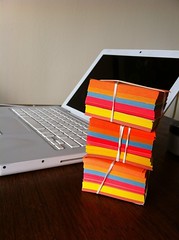It’s About Needs.
 I’ve been doing various bits of writing lately, both for my blogs and for other purposes. This morning I was sitting at a cafe, scrawling ideas in my notebook, and decided I needed to take a step back and follow the oft-mentioned advice of “one card, one idea, arrange, write.”
I’ve been doing various bits of writing lately, both for my blogs and for other purposes. This morning I was sitting at a cafe, scrawling ideas in my notebook, and decided I needed to take a step back and follow the oft-mentioned advice of “one card, one idea, arrange, write.”
“I need some index cards!” declared my Front Brain.
“No, you don’t need index cards,” interrupted my Back Brain, “you need small bits of paper large enough for capturing ideas and easy to arrange. There is more than one way to do it.”
“Oh…yeah, I guess you’re right,” Front Brain conceded.
This internal dialog—aided by knowledge gained by working in a printshop for five years during college—led me to the independent printer down the street. $2.00 later and I have a stack of around eight hundred small bits of paper, perfect for my purposes and cheaper than index cards. As an extra bonus the printer made two bucks on something which he otherwise would have chucked into recycling. I’m happy, the printer is happy and nary an index card is in sight.
“If I had asked people what they wanted, they would have said faster horses.”
― Henry Ford
We in the tech industry are in the business of fulfilling needs. Accounting needs to process expense reports more quickly. IT needs log monitoring and notifications for potential issues. Your grandparents need to see pictures of their new great grandchild. I need to buy a four pound bag of cat food every month.
Please note: These needs are not “Logon to internal financial system integrated with payroll processor,” or “Implement Nagios or Splunk” or “Teach grandparents to use email so they can view Flickr links” or “Order cat food through Amazon Subscriptions.” These are all very valid implementation options but they’re not needs.
It’s so easy to get caught up in expectations and experiences, jumping straight to a possible implementation rather than slowing down and taking a moment to look at the bigger picture. Let’s take my index card problem as an example. What I initially said to myself:
Darn, but there has to be an easier way to organize these thoughts.
Conventional wisdom (and an army of high school English Comp teachers) says that the response to the problem of thought organization is “index cards.” However that answer doesn’t take into consideration my personal constraints:
- Minimal expense
- Minimal material waste
- Minimal space usage
Would index cards have met these needs? Yes, they would have. That said, my local-printer-supplied option meets those needs even better. These cards are cheaper, would otherwise have been scrapped, and are smaller than commercial index cards. As a user, I am much more “delighted” (an adjective which I deplore but which I must admit applies here). I am now much more likely to use these cards because I am happier with the end product.
The key to generating this “delight” (I still hate that word) was not my prior knowledge of printshop operations though that was, admittedly, helpful for the final product. No, the key was knowing to ask myself, “Yes, but what are you really trying to accomplish?” and then surveying the potential options.
For the record: getting to the root of user needs is not usually as simple as having them answer a single question. There are very good reasons why there are people who do nothing but determine user needs. That said, the question is important enough for everyone on a team to keep it in mind throughout the design and development process. If at any point you cannot answer the questions “What?” and “Why?” then you should circle the wagons and start the process of getting these matters clarified. You’ll be doing the team a favor. Nothing is as effective as a team that understands not only what they’re trying to produce but, most importantly, why they are trying to do it.
📣 Like what you see? Hire me! 📣
I can bring my decades of experience and knowledge of business strategy, software development, servant leadership, and open source to your organisation.
Check out my resume then contact me today!